Brad Mormann | Originally published in GameKeepers: Farming for Wildlife Magazine. To subscribe, click here.
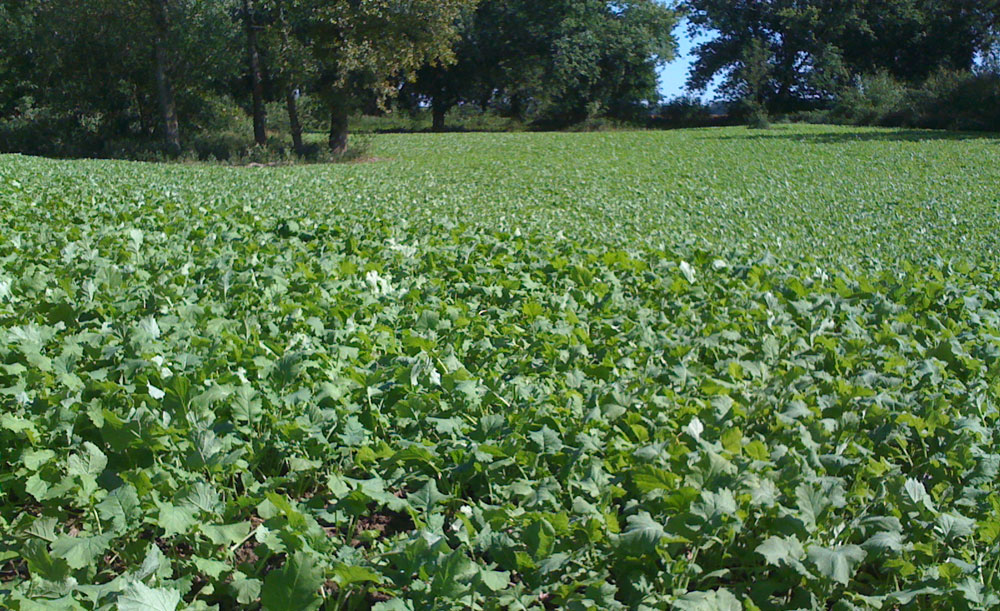
Late summer, probably more than any other time of year, hunters are thinking about trying their first food plot or adding more plots to their hunting property. Antlers are beginning to be more than a thought for “next season” but a thought of “this season.” In an effort to ever improve their deer herd and hunting success, food plots always rise to the top. Similar to buying a bow or a new scope, research is often done to determine, first, if the item is really needed, and second, how much it will cost.
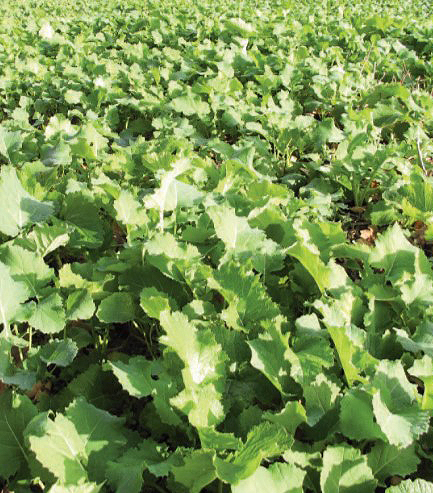
close to brassicas like radishes, rape, turnips or kale. There are
just so many categories and characteristics that show how
brassicas simply blow away all other comparable crops. For
many gamekeepers, it’s their favorite type of planting.
Food-plotting, just like any hobby, requires some investment of time and resources. It’s never a bad idea to do the math and think about the cost/benefit ratio. Sometimes it reassures us that the cost is well worth the effort while other times it causes us to become more innovative.
For example, in my backyard of the upper-Midwest, agriculture is all around me, but I still want to have my food plots for two main reasons – attraction and winter carryover. These two things can be accomplished with a winter hardy planting of brassicas. Brassicas are one of my go-to forages for attraction in the mid-to-late hunting season. Shoot, some years its one of my go-to plantings for early season, too. This is because each deer herd reacts differently to them. Some will start chomping them right out of the chute while others will wait until temperatures drop and frosts occur more frequently.
Depending on your goals this can be a great thing. Early in the season I often find myself splitting my time between planted food sources and the first oaks dropping acorns. Acorns are “golden” early in the season in my neck of the woods as deer just can’t resist them. However, as the season progresses it is more and more obvious the acorns become less plentiful and my hunting revolves more around other quality food sources like the brassicas.
The second reason plots are important to me is the winter carryover of my deer herd. Even in agricultural dominated states, food can get pretty scarce throughout the winter after the fields are picked and the arctic winds have little to slow them down. This time of year can pack a pounding on the health of a herd. Instead of gaining or even maintaining body growth, herd health is often on a downhill slide. This is where a quality food plot of brassicas steps in to provide the forage tonnage when it matters most, to the tune of 10+ tons per acre depending on rainfall and nutrient availability and how many days it grew before cold temperatures slowed growth and eventually shut it down. If antlers or fawn production are on your mind, taking care of a herd 12 months of the year should be also. Anyway, enough with the “sense” let us talk about the “dollars.”
Here are the numbers often rattling around in my head during early August when my truck is loaded down with all the goodies I need to create a fall food plot.
1-Acre Brassica Food Plot
● 2 quarts of Roundup Herbicide = $15.60 ($78 per 2.5 gallons)
● 1 – 9 lb bag of Biologic’s Maximum brassica mix = $59.99
● 350 lbs of 13-13-13 fertilizer = $157.00 ($22.41 per 50 lb bag)
● 3 tons per acre Ag Lime plus delivery = $37.50 ($12.50 per ton)
Total = $270 - yields ten tons of forage or more
Additional Items may include food plot prep. A few of the options I utilize depending on the location and type of vegetation are to 1) mow and a couple weeks later spray the new growth, 2) spray and then mow if needed to knock down the dead vegetation for proper equipment operation, or 3) some sort of tillage such as disking. If equipment, time or experience is in short supply, options are available.

“Table 1” is a list of field operations that you can have a custom operator come and do for you. This information is for Iowa, but most states have similar information available online.
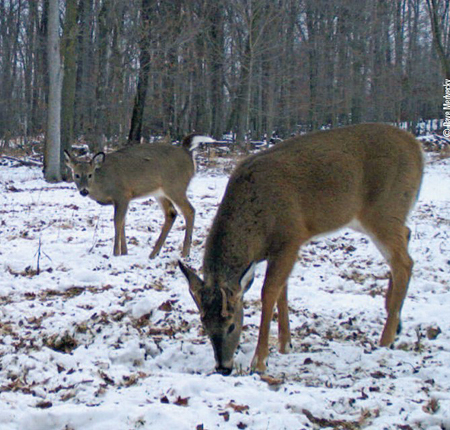
important to them. One of the author’s most important jobs for his food
plots is to aid in winter carryover. To grow big antlers in northern venues
winter nutrition is a key.
After looking at the numbers it’s important to bring the totals together. In the case of the Maximum blend the cost to get a plot growing with my own equipment is $270 per acre to produce 10 tons (20,000 pounds) (or more) of forage. That is $27 per ton. The takeaway being a food plot is a bargain and the seed is the cheapest part.
Doing these types of calculations creates the whole picture for me when deciding how many acres of food plots to plant each year. These numbers in addition to many memories of successful hunts over plots like this throughout the years, has me annually loading the truck with seed and fertilizer.
I will never forget one of my first food plotting experiences. I had planted several plots on a property in Missouri. Every acre had its challenges with dense fescue sod to 10 foot tall saplings growing all over them. After initially burning off the plots, then several passes with a disk, fertilizer buggy, and no-till drill, the plots took off. A couple of months later they were lush and the rut was in full swing.
On “day 1” of the Missouri rifle season a strong south wind was forecasted to dominate the first several days of the hunt. Due to the wind and chances for a long shot I chose to sit on the ground on the north end of a five acre plot of Biologic’s Premium Perennial. The first morning was exciting with several does and a couple of young bucks feeding through.
The second morning started slow but around mid morning I caught movement along the far edge of the plot. Unsure of exactly what it was I used my grunt call and the deer quickly turned and trotted across the plot. It was a ten point I had several trail camera pictures of and he was literally trotting directly at me. Now remember, I was sitting on the ground under a tree. I tried to get the gun up quickly but the buck was moving too fast in my direction. By the time I had it on him, all that was in the scope was fur, lots and lots of fur. So much fur that I couldn’t tell where exactly I was aiming. The buck was literally ten feet away and my heart was racing. I was only seeing fur because my left eye had shut in the excitement. I had to peer over the scope to see where to aim. Everything in my body said, wow, he is close!
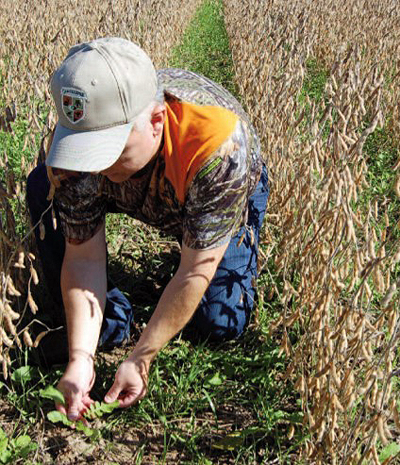
food for your herd is to double-crop agricultural plantings.
Here you see our Editor in Chief examining some radishes
and rye planted with a hi-boy tractor and an air broadcaster
in a cash-crop soybean field. The beans were harvested
later that same day.
Although the ground was level I was actually shooting up at him. I settled back down to look through the scope again, found what I thought was good placement, and squeezed the trigger… A few minutes later retracing the buck’s tracks across the plot, the value of a food plot was for me, a quality whitetail. From then on I was hooked on food plots and the antlers of that buck have graced my office for years. How much is that worth?
These experiences can be truly “priceless” as each one develops new and exciting memories. However, if you are still on the fence due to budget or time commitment concerns there are ways to bring the cost of your next or first food plot down to a level that fits your needs.
Last issue I wrote about broadcasting brassicas into a standing agricultural field of soybeans. The cost was literally seed and time, quality time that I spent with my son. I simply broadcasted Biologic’s Maximum brassicas mix directly into the standing soybeans as they turned brown during late summer. The farmer came in a couple of weeks later and harvested the beans. The plots had plenty of nitrogen in the soil from the soybeans and the farmer touched off the entire field with fertilizer. No, the farmer did not place the fertilizer specifically for my plot; he was doing it to ensure his fields were appropriately fertilized for his crops. I just took the initiative to talk to him about what my goals as a hunter were and we were able to fit them into his plans as a farmer.
I reduced his cover crop seed costs, the brassicas helped hold nutrients in the upper portions of the soil so they wouldn’t leach beyond his crops root growth, and I provided green tillage for spring - cost savings at its best. So my total cost per acre on that food plot was the Maximum seed - $59.99, you’ve gotta love a win, win like that.
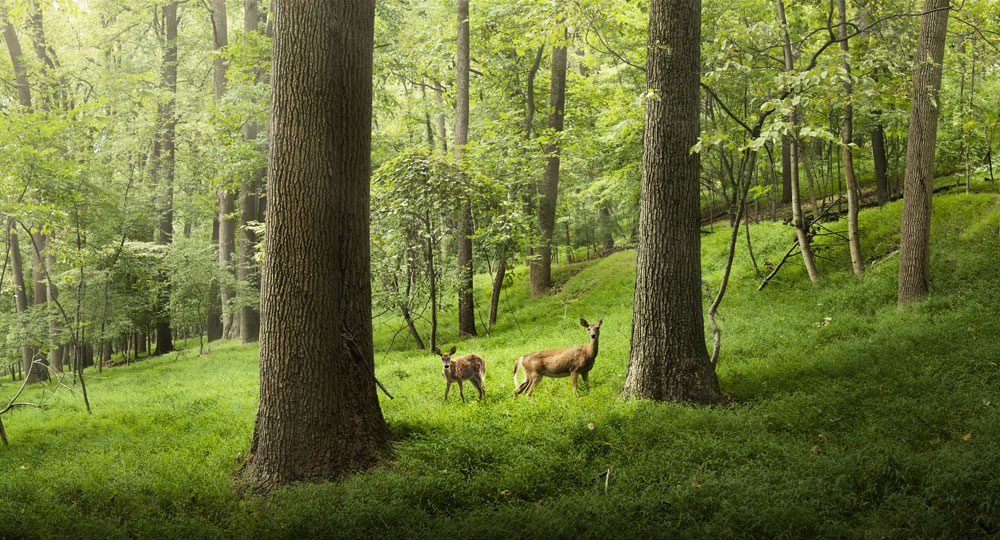
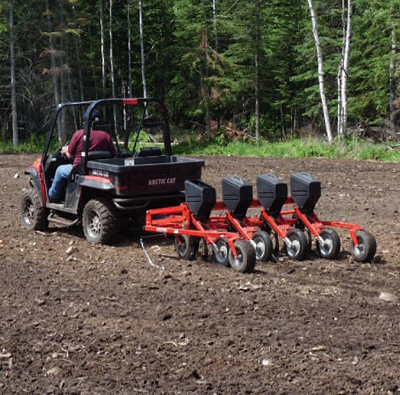
different levels. If you don’t have the money to pay for the
best of everything, there are a number of things we can do
to cut costs - planning sound crop rotations, double-
cropping agricultural fields, or using organic materials
(manure) or “green fertilizer” in place of granular options,
just to name a few.
Other opportunities like this exist where you can save money while also having food plotting success. Another agricultural technique is to work with farmers that chop their corn. The process of chopping removes just about everything including a large percentage of warm season weeds that will throw in the towel given the late time of year. Because corn chopping is done in later summer when the field is still at least partially green, there is often several weeks available to get a food plot growing.
Unless you are planting a legume, you will need some nitrogen because corn is a huge consumer of it. A soil test would also be beneficial but it would need to be done before the corn is chopped to ensure you have all your fertilizer together to prepare for planting. However, even in this case chopped fields are often the first place farmers want to place the manure they have been storing up all summer because the fields could not be entered. If this is the case, seed may once again be all that is required to make a high quality food plot. There are many more of these types of opportunities out there where you can tag on to another land management activity like utilizing logging decks, logging roads, or a small woodland canopy opening to make a food plot fit into any budget.
Having success in the field can come in many ways - food plots provide tons of quality forage, have the potential to attract deer to within close range and can improve a deer herd’s health. What is that worth to you? With a few dollars (or a little ingenuity or extra elbow grease), seed, fertilizer and a little knowhow, you have the opportunity to produce food plots on your hunting property each and every year.































